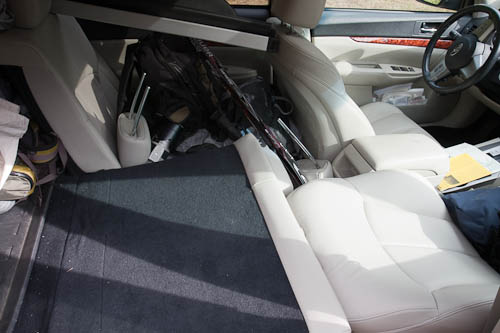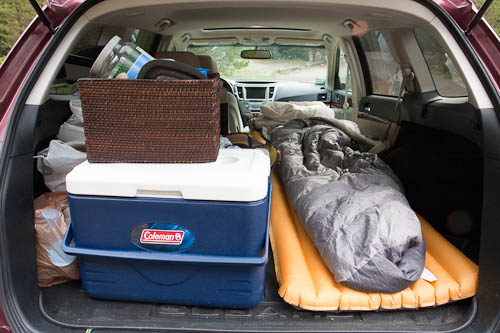Will I suffocate if I sleep in my car?
I have been asked several times now whether I “camp” by sleeping in my car. After all, Sam is a wagon, so it seems like there should be enough space, right?
The reality is that I don’t like sleeping in cars. I tried it once a few years ago with my old Outback in a national forest in northern Minnesota, but the experience was quite unpleasant. Condensation built up on the windows, the air inside was quite cold, and I couldn’t open any windows because of the swarming hordes of blood-sucking mosquitoes waiting to get in. Actually, a few did manage to get in, presumably through the ventilation system. Not a good night’s sleep.
Still, that was then, and this is now. I decided to give it another try in a campground in Grand Teton National Park.
One of the nice undocumented things about the 2010 and newer Outbacks is that the rear seats folded down are at the same level as the front seats folded back. One needs only to remove the headrests to create an eight-foot long, nearly flat surface.
The key word there is “nearly,” since there were still some annoying bumps to contend with. I got out my excellent Exped UL7 air mattress and put my sleeping bag on top of it. All of the rest of my gear got pushed off to the side.
The evening started off well. The temperature was comfortable, Sam’s cabin air filter kept the mosquitoes from entering via the ventilation system, and I had a great view of the stars through the moonroof glass. I drifted to sleep.
A couple hours later, I jolted awake with a horrifying thought: could I suffocate by sleeping in such an enclosed space? A bunch of frantic web searches on my smartphone turned up no reliable reports of people suffocating in cars where there had been no sources of carbon monoxide. Lots of people have died from leaving their cars running, but it seems that nobody has ever died from sleeping a night in a non-running car.
Just to be safe, I opened a door for a while to do an air exchange before going back to sleep.
I survived (obviously), but I started to wonder: if we assume Sam’s interior is perfectly sealed, how long would I be able to survive on the air inside?
Let’s assume that Sam’s cabin volume is 102 cubic feet. I have about 20 cubic feet of gear, and I myself occupy about 12 cubic feet. That leaves 70 cubic feet of air.
There are two primary suffocation modes to worry about: hypoxia and CO2 poisoning. It turns out that humans notice high CO2 levels — they are perceived as being very unpleasant or even painful — but humans are very poor at detecting low oxygen levels. For this scenario, I’m going to assume that I’d wake up if CO2 levels got dangerously high, which leaves only low O2 levels to worry about.
For simplicity, I’m also going to gloss over the fact that I was camping at 7,000 ft of elevation. Compensating for the lower oxygen levels at altitude is left as an exercise for the reader.
Thanks to a handy page at Oak Ridge National Labs, we see that the formula for calculating maximum residence time based on oxygen levels is:
T = (V) (21 – L) / (100 n C)
where V is the volume of air in ft^3, L is the acceptable lower limit of oxygen in percent, n is the number of people, and C is the oxygen requirement per person per minute.
I’m going to assume that I’m a healthy adult male, so L is 12% and C is 0.007 ft^3 min^-1. Recall from above that the volume of available air is 70 ft^3. Plug in the numbers:
T = 70 * (21 – 12) / (100 * 1 * 0.007)
= 900 minutes
= 15 hours
I’m not going to be sleeping in there for anywhere close to 15 hours, so I think I’m safe.
Will I be doing more back-of-the-car camping? Doubtful. I really, really like being able to sit up straight in my tent without hitting my head on the ceiling, something that’s impossible in the back of the Outback.




You should also factor in air passing through the cabin air filter as well as the equalization vent in the rear corner near the bumper.
Also, if it was raining cats and dogs, I find camping in the car much more comfortable than pitching a tent.
@Shaun Good points. I wasn’t sure how to account for the flow through the cabin air filter, and I wasn’t aware of the existence of the equalization vent, but they would both extend the residence time, perhaps indefinitely.
What does the equalization vent look like?
I never even considered suffocating in the car. I invested four months in a western road trip, a most wonderful, lifetime experience. I had Clea the wonder dog along. How would a 50 lb. dog alter the oxygen use calculation? After all of these years, I now have to extrapolate.
This was 1977. I had a 1974 Toyota Corona station wagon, which of course, did not have a back seat that went down flat, not to mention going flush with the front seat. Cars were less sophisticated than Sam. I removed the back seat and constructed a plywood deck level with the rear deck. I installed a hinged hatch in the plywood deck to store infrequently used items. This also created more clear deck for Clea and my frequently needed items.
We traveled to and through all the great western parks and monuments, known and unknown, with great entusiasm and enjoyment. Once in a while, we were in a wonderful park where Clea’s presence was not necessarily legal. We sure didn’t want to break the law! Other times we found ourselves in our tent within earshot of other adventurers and dogs, or visited at night by friendly bears, racoons, skunks, and other such interested parties. With Clea’s protective nature, we sometimes became the nosiest neighbors on the block. So, we spent more time sleeping in the car than I had ever planned. There is no question there was some loss of intimacy with nature, but sometimes it just had to be.
Other times, car camping offered an opportunity. I will never forget falling asleep at the ocean end of a pier in Santa Barbara to the gorgeous fading rays of sunset and awaking to the pink-orange glow of sunset as the waves crashed all around and below me. There was no tent or even open-air camping on that pier, and probably no car camping, but our shielded presence went unnoticed and we experienced a life affirming event.
I’m glad I didn’t think about suffocating sleeping in the car on that night or having to calculate the oxygen use of Clea, but I do remember some very mellow morning awakenings. Was that oxygen deprivation? I hope not.
here’s a picture of the rear vent courtesy of a member on the forester forum – http://www.subaruforester.org/vbulletin/attachments/f80/3307d1162007128-how-remove-rear-bumper-vents2.jpg
as you can see, they’re just thin rubber flaps that are far from air-tight. They flip open wide when internal pressure increases such as when closing a door.
@Greg Hicks Did you ever do any long-form writing about that trip? Seems like you might have the material for something compelling.
@Shaun Ah, I see. I guess I had never thought about how the car cabin has its pressure equalized with the outside.
One way to combat that concern is with the “Skeeter beater” style screen to place over the rear windows. No SeeUm mesh with magnets sewn and or glued around the edges to create a seal around your car window and allow you to lower it and get a bit of air flow if desired. Thanks for the tip on the seats, I was not aware of that either!